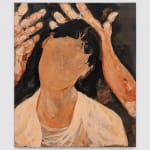Arjan Martins
Sem título [Untitled], 2024
acrílica sobre tela
[acrylic on canvas]
[acrylic on canvas]
60.5 x 50.5 x 6 cm
[23 7/8 x 19 7/8 x 2 3/8 in]
1.6 kg
[23 7/8 x 19 7/8 x 2 3/8 in]
1.6 kg
Copyright The Artist
Further images
A pintura de Arjan Martins vai além de rastros do passado e se torna ensejo de um tempo cíclico: o diálogo com o anacronismo do tempo revela uma reivindicação política...
A pintura de Arjan Martins vai além de rastros do passado e se torna ensejo de um tempo cíclico: o diálogo com o anacronismo do tempo revela uma reivindicação política a partir do espaço pictórico. O direito à vida para os corpos negros se apresenta constantemente nas telas de Martins. Nesta obra, o artista apresenta uma mulher sem características faciais, remetendo uma identidade rasurada e traduzindo uma negação da imagem. Desta forma, produz uma contundência gestual que multiplica as direções expressivas contidas na forma, além de alegorizar um coletivo invés do individual.
[Arjan Martins' painting goes beyond traces of the past and becomes an opportunity of a cyclical time: the dialog with the anachronism of time reveals a political claim for the pictorial space. The right to life for black bodies is constantly presented in Martins' paintings. In this work, the artist presents a woman with no facial features, referring to a torn identity and a denial of the image. In this way, he produces a gestural forcefulness that multiplies the expressive directions contained in the form, as well as allegorizing a collective rather than an individual.]
[Arjan Martins' painting goes beyond traces of the past and becomes an opportunity of a cyclical time: the dialog with the anachronism of time reveals a political claim for the pictorial space. The right to life for black bodies is constantly presented in Martins' paintings. In this work, the artist presents a woman with no facial features, referring to a torn identity and a denial of the image. In this way, he produces a gestural forcefulness that multiplies the expressive directions contained in the form, as well as allegorizing a collective rather than an individual.]
1
of
21
![Arjan Martins, Sem título [Untitled], 2024](https://artlogic-res.cloudinary.com/w_1800,h_1320,c_limit,f_auto,fl_lossy,q_auto/artlogicstorage/agentilcarioca/images/view/9cbf259afcad39790294aac394f13893j/agentilcarioca-arjan-martins-sem-t-tulo-untitled-2024.jpg)
![Arjan Martins, Sem título [Untitled], 2024](https://artlogic-res.cloudinary.com/w_1800,h_1320,c_limit,f_auto,fl_lossy,q_auto/artlogicstorage/agentilcarioca/images/view/6b7c72b16cbcb0368b5a8f7d5e62a9afj/agentilcarioca-arjan-martins-sem-t-tulo-untitled-2024.jpg)
![Arjan Martins, Sem título [Untitled], 2024](https://artlogic-res.cloudinary.com/w_1800,h_1320,c_limit,f_auto,fl_lossy,q_auto/artlogicstorage/agentilcarioca/images/view/e4b0087fc32d42363cd57523257f45b0j/agentilcarioca-arjan-martins-sem-t-tulo-untitled-2024.jpg)
![Arjan Martins, Sem título [Untitled], 2024](https://artlogic-res.cloudinary.com/w_1800,h_1320,c_limit,f_auto,fl_lossy,q_auto/artlogicstorage/agentilcarioca/images/view/0c2f8667d0890e8c2d1a9f56cc10a8a1j/agentilcarioca-arjan-martins-sem-t-tulo-untitled-2024.jpg)



